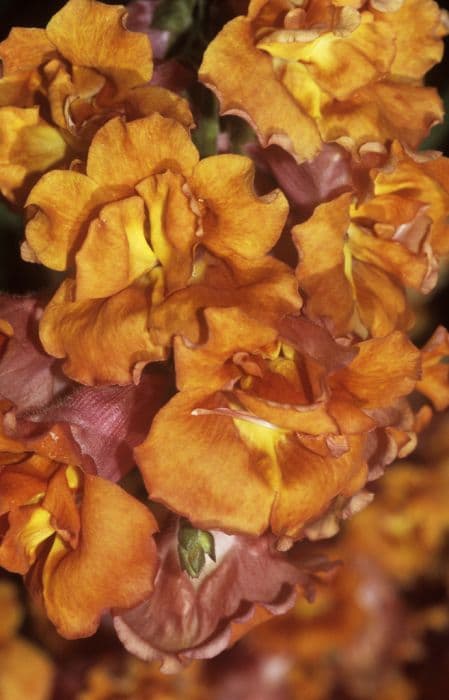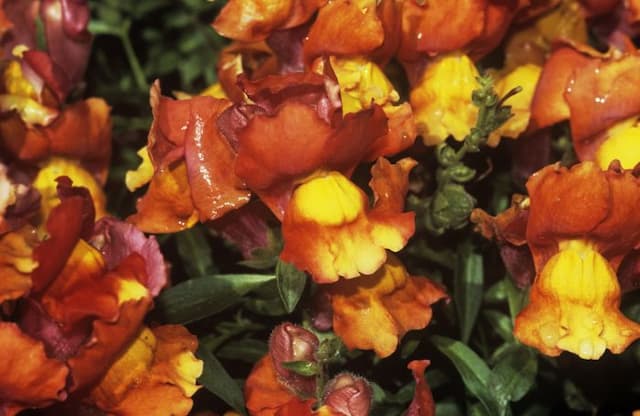Summer snapdragon Angelonia angustifolia Angelmist Lavender Bicolor = 'Balanglabi' (PBR) (Angelmist Series)

ABOUT
[AngelMist Lavender Bicolor] is a dense, low-growing variety with lance-shaped, dark green leaves and tube-shaped purple flowers which appear in the summer
About this plant
 Names
NamesFamily
Plantaginaceae
Synonyms
Summer Snapdragon, Angel Flower, Angelonia
Common names
Angelonia angustifolia Angelmist Lavender Bicolor = 'Balanglabi' (PBR) (Angelmist Series).
 Characteristics
CharacteristicsLife cycle
Perennials
Foliage type
Evergreen
Color of leaves
Green
Flower color
Lavender
Height
1-2 feet (30-60 cm)
Spread
1-2 feet (30-60 cm)
Plant type
Herb
Hardiness zones
9
Native area
Mexico Central America
Benefits
 General Benefits
General Benefits- Enhances Garden Aesthetics: Its lavender and white bicolor flowers add a striking visual appeal to borders and garden beds.
- Drought Tolerant: Once established, it is quite resilient to dry conditions, reducing the need for frequent watering.
- Heat Resistant: It thrives in high temperatures, which makes it suitable for hot and sunny gardens.
- Continuous Blooming: Provides long-lasting flowering throughout the summer and into fall without the need for deadheading.
- Low Maintenance: Requires minimal pruning and upkeep, making it ideal for gardeners seeking low-effort plants.
- Attracts Pollinators: The flowers attract butterflies and bees, promoting pollination in the garden.
- Deer and Rabbit Resistant: Less likely to be eaten by deer and rabbits, which can help to preserve the beauty of your garden.
- Adaptable Usage: Suitable for use in container gardens, hanging baskets, and as a bedding plant, offering various landscaping options.
 Medical Properties
Medical PropertiesThis plant is not used for medical purposes.
 Air-purifying Qualities
Air-purifying QualitiesThis plant is not specifically known for air purifying qualities.
 Other Uses
Other Uses- Artistic Dye: The flowers of Angelonia can be used to produce a natural dye for fabrics or artwork, resulting in a range of lavender hues.
- Photography Subject: Due to its striking bicolor flowers, Angelonia serves as a captivating photography subject for botanical photographers and hobbyists alike.
- Edible Decorations: Although not a common food item, the flowers of Angelonia can be used as a decorative, edible garnish on salads and desserts after proper identification and ensuring they're free from pesticides.
- Educational Tool: Angelonia can be used in schools or educational programs to teach students about plant biology and the natural coloration process in flowers.
- Culinary Experiments: Creative chefs might use the subtle flavors of Angelonia blooms to infuse syrups or sugars for unique culinary creations, while still avoiding mainstream consumption.
- Ikebana (Japanese Flower Arranging): The structure and color of Angelonia make it suitable for Ikebana, providing an untraditional choice in the art of Japanese flower arranging.
- Homemade Potpourri: Dried Angelonia flowers can be added to potpourri mixes to provide texture and a mild fragrance to the concoction.
- Floral Jewelry: Small Angelonia flowers can be incorporated into hand-crafted jewelry such as earrings, pendants, or hair accessories, sealed in resin for preservation.
- Greeting Cards: Pressed Angelonia flowers can be used to embellish greeting cards or bookmarks, providing a personal touch to handmade stationery.
- Plant Photography Backdrop: The Angelonia's vivid colors and full blooms can serve as an attractive backdrop for photographing smaller objects or other plants.
Interesting Facts
 Feng Shui
Feng ShuiThe plant Summer Snapdragon is not used in Feng Shui practice.
 Zodiac Sign Compitability
Zodiac Sign CompitabilityThe plant Summer Snapdragon is not used in astrology practice.
 Plant Symbolism
Plant Symbolism- Healing: Angelonia, often known as Summer Snapdragon, has been used in traditional medicine, creating an association with healing and the soothing of ailments.
- Strength: This plant's robust growth and resilience to high temperatures can symbolize strength and the ability to withstand challenges.
- Serenity: The soft lavender color of the Angelmist Lavender Bicolor is commonly associated with tranquility and peace.
- Spiritual Connection: Its angelic name may evoke a sense of spirituality and a connection to the divine, often used in gardens designed for contemplation and reflection.
- Grace: The Summer Snapdragon's delicate and graceful blossoms can symbolize elegance and poise.
 Water
WaterThe Summer Snapdragon, when cultivated, requires consistent moisture but should not be overwatered. It's best to water the plant when the top inch of soil feels dry to the touch. Water thoroughly until excess water drains out, which should be roughly once a week, depending on the climate and humidity. During hotter, drier periods, more frequent watering may be necessary, about twice a week. Typically, using about a gallon of water per plant should be sufficient to keep the soil moist but not waterlogged.
 Light
LightSummer Snapdragon thrives in full sunlight, which means it needs at least 6 to 8 hours of direct sun each day. Choose a spot in the garden or on your property that receives plenty of sun throughout the day with minimal shade. Avoiding overly shaded areas will ensure the plant grows healthily and produces plenty of its vibrant blooms.
 Temperature
TemperatureSummer Snapdragon operates well in a wide range of temperatures, but prefers warmer climates. It can survive minimum temperatures down to 30°F, but growth may be stunted in cooler temperatures. The plant is happiest in a range somewhere between 70°F and 85°F, and maximum temperatures for healthy growth should not exceed 90°F. Avoid placing it in locations where temperatures could dip below freezing, as this can damage the plant.
 Pruning
PruningPruning Summer Snapdragon is essential for encouraging bushier growth and more blooms. Deadheading, or removing spent flower spikes, will stimulate new flowers to form. It's typically recommended to prune or pinch back the tips of the stems occasionally to promote branching, which you can do every few weeks during the active growing season. The best time for more extensive pruning is in late winter or early spring before new growth begins.
 Cleaning
CleaningAs needed
 Soil
SoilSummer Snapdragon, or Angelonia angustifolia, thrives best in a well-draining potting mix with a pH range of 5.5 to 6.5. A good soil recipe would be a blend of peat moss, perlite, and vermiculite in equal parts to ensure proper drainage and aeration. Regular garden soil should be avoided as it can retain too much water and lead to root rot.
 Repotting
RepottingSummer Snapdragon should be repotted annually or when it outgrows its container. Check the root system in spring before new growth starts; if roots are circling the pot, it's time to repot in a slightly larger container.
 Humidity & Misting
Humidity & MistingSummer Snapdragon prefers moderate humidity levels but is quite adaptable to lower humidity environments. Avoid overly humid conditions as this can promote fungal diseases.
 Suitable locations
Suitable locationsIndoor
Place Summer Snapdragon in bright, indirect light indoors.
Outdoor
Plant in full sun to partial shade outdoor for best growth.
Hardiness zone
9-11 USDA
 Life cycle
Life cycleThe life cycle of Angelonia angustifolia 'Balanglabi', commonly known as Summer Snapdragon, begins with seed germination, which requires warm temperatures and light. After germination, the seedlings grow into juvenile plants with characteristic foliage and begin vegetative growth. As they mature, they enter the flowering stage, producing lavender-bicolor blooms that attract pollinators. Following pollination, the flowers develop into seed capsules containing seeds that can be dispersed to create new plants. Gradually, as environmental conditions become less favorable, the plant enters senescence, where growth slows and the plant may die back, particularly if faced with frost or prolonged cold. In milder climates or with protection, Angelonia may persist through winter, re-sprouting from the crown in spring.
 Propogation
PropogationPropogation time
Spring-Summer
Angelonia angustifolia Angelmist Lavender Bicolor, commonly known as Summer Snapdragon, is typically propagated through stem cuttings. The most popular time to propagate is during the late spring or early summer when the plant is actively growing. To propagate through cuttings, a grower will select a healthy stem that is about 3 to 5 inches (approximately 7.6 to 12.7 centimeters) long and cut it just below a leaf node using a clean, sharp pair of scissors or a knife. The lower leaves are then removed and the cutting is dipped in a rooting hormone powder to encourage root development. The prepared cutting is then planted in a moist, well-draining potting mix and covered with a plastic bag or placed in a propagation chamber to maintain high humidity around the cutting. It usually takes several weeks for the cutting to root, after which it can be transplanted to a permanent location.









